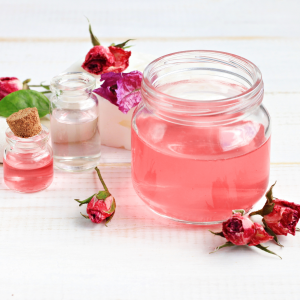Rose Water Benefits and How to Make It at Home

Nothing says “love” like a gift of roses — whether a blossoming bouquet or a single bloom adorned by a ribbon. If only roses would last forever! Fortunately, even though they have a limited shelf life, you can continue to enjoy their fragrant beauty by making rose water. What is rose water? Basically, it’s water infused with the scent and flavor of rose petals. Natural rose water is simple to create and has multiple uses. Let’s look at some of its benefits and ways to incorporate it into your daily skincare and wellness routine.
Benefits of Rose Water
Rose petals contain various beneficial plant compounds, including antioxidants, flavonoids, terpenes, and polyphenols that give them anti-inflammatory, astringent, and calming properties. While scientific studies on rose water are limited, it has become known for helping to fight the effects of free radicals, tone and brighten skin, fight bacteria that cause infections, and ease pain.
Additionally, people have claimed rose water has strong spiritual effects, promoting a healthy mind and body as it helps clear energy blockages and support positivity.
Rose Water Uses
Natural rose water is versatile and used in various skincare and household applications.
- Face toner or body spritz (Note that individuals with sensitive skin may find it irritating. We recommend testing it on a small patch of skin before using it on the face or all over the body.)
- Room freshener
- Linen spray
- Bath infusion
- Digestive tonic
DIY Rose Water Recipes
The basic steps for making red rose water at home include:
- Gather your ingredients: Petals from approximately eight organic red roses, enough distilled water to cover the petals (approximately ¾ gallon).
- Add rose petals to a large pot.
- Pour in just enough distilled water to cover the petals.
- Turn on the burner to medium-low heat and bring the mixture to a simmer.
- Cover pot, turn burner to low, and let simmer until the petals fade to a pale pink color (approximately 30 minutes).
- Let the mixture cool.
- Strain the liquid into a large glass bowl using a colander (to leave the petals behind).
- Pour the rose water into a Mason jar or other clean, sealable glass container to store it. Discard the petals.
Below are several recipes featuring rose water for skin care, air and fabric freshening, and as a beverage. They require minimal ingredients and are easy to make.
Bring on the Flower Power
As you can see, rose water’s versatility justifies the small bit of effort involved in making it on your own. If you try it, let us know your thoughts, and tell us your favorite ways to use it.
P.S. If you’re a fan of floral scents in your skincare products, you’ll love our Garden of Eden Body Scrub and Body Butter. They feature essential oils of rose geranium, lavender, cedarwood, and palmarosa in a rich formulation of nourishing organic sunflower oil, coconut oil, and cocoa butter.
Sources:Lee MH, Nam TG, Lee I, Shin EJ, Han AR, Lee P, Lee SY, Lim TG. Skin anti-inflammatory activity of rose petal extract (Rosa gallica) through reduction of MAPK signaling pathway. Food Sci Nutr. 2018 Oct 25;6(8):2560-2567. doi: 10.1002/fsn3.870. PMID: 30510758; PMCID: PMC6261181.
Safdar, Yusra & Malik, Taqdees. (2020). Antibacterial activity of the rose extract. Open Access Journal of Complementary & Alternative Medicine. 2. 10.32474/OAJCAM.2020.02.000144.

No comments yet. Be the first!